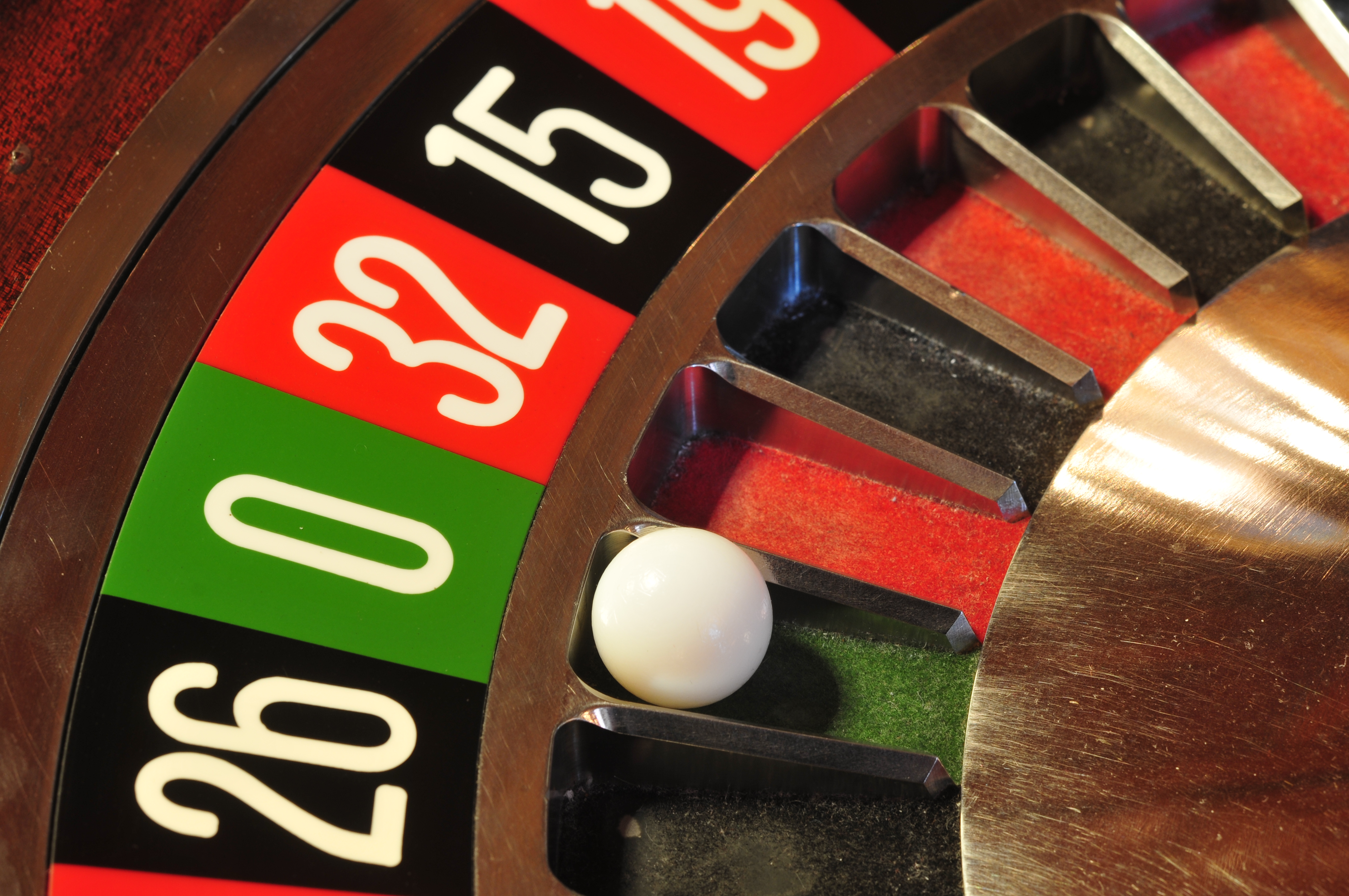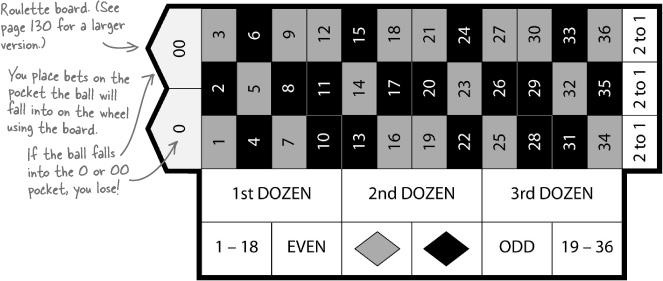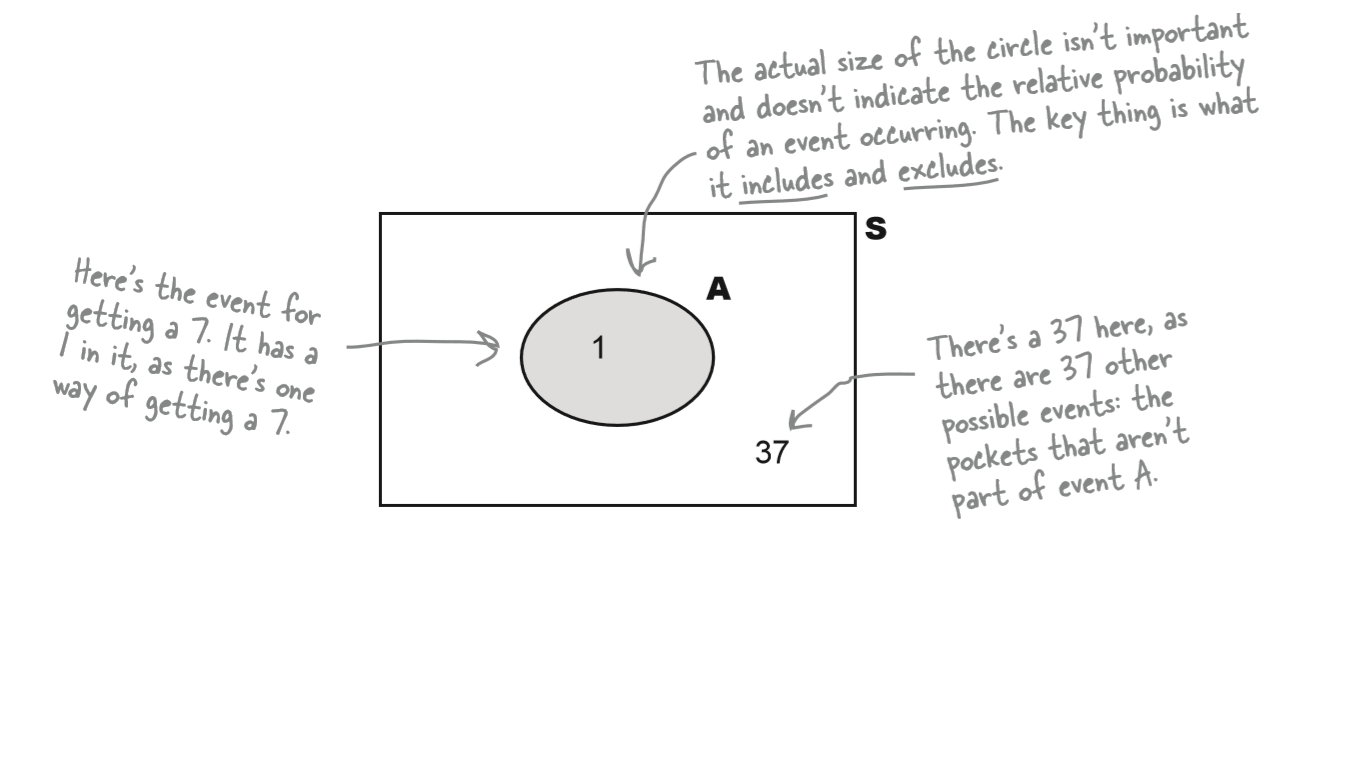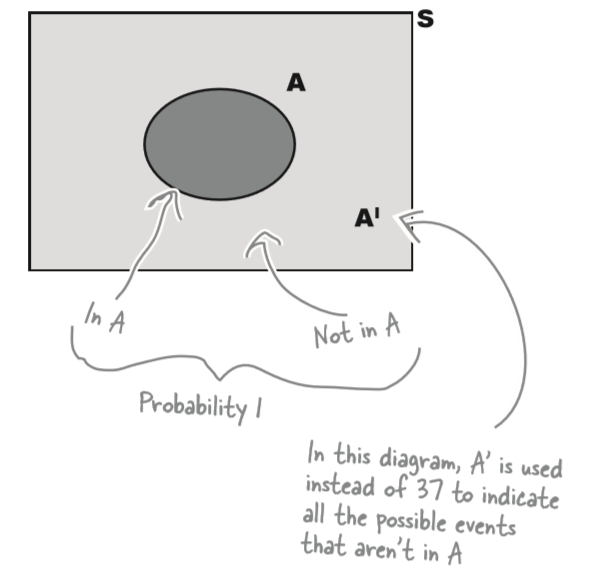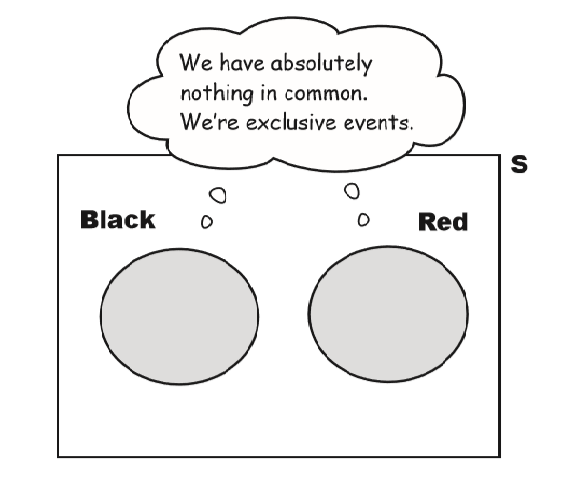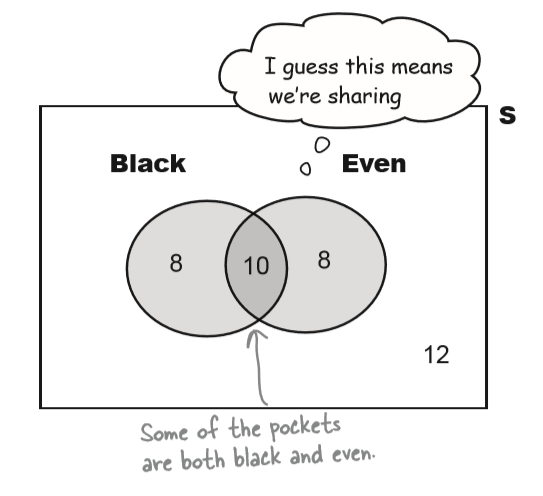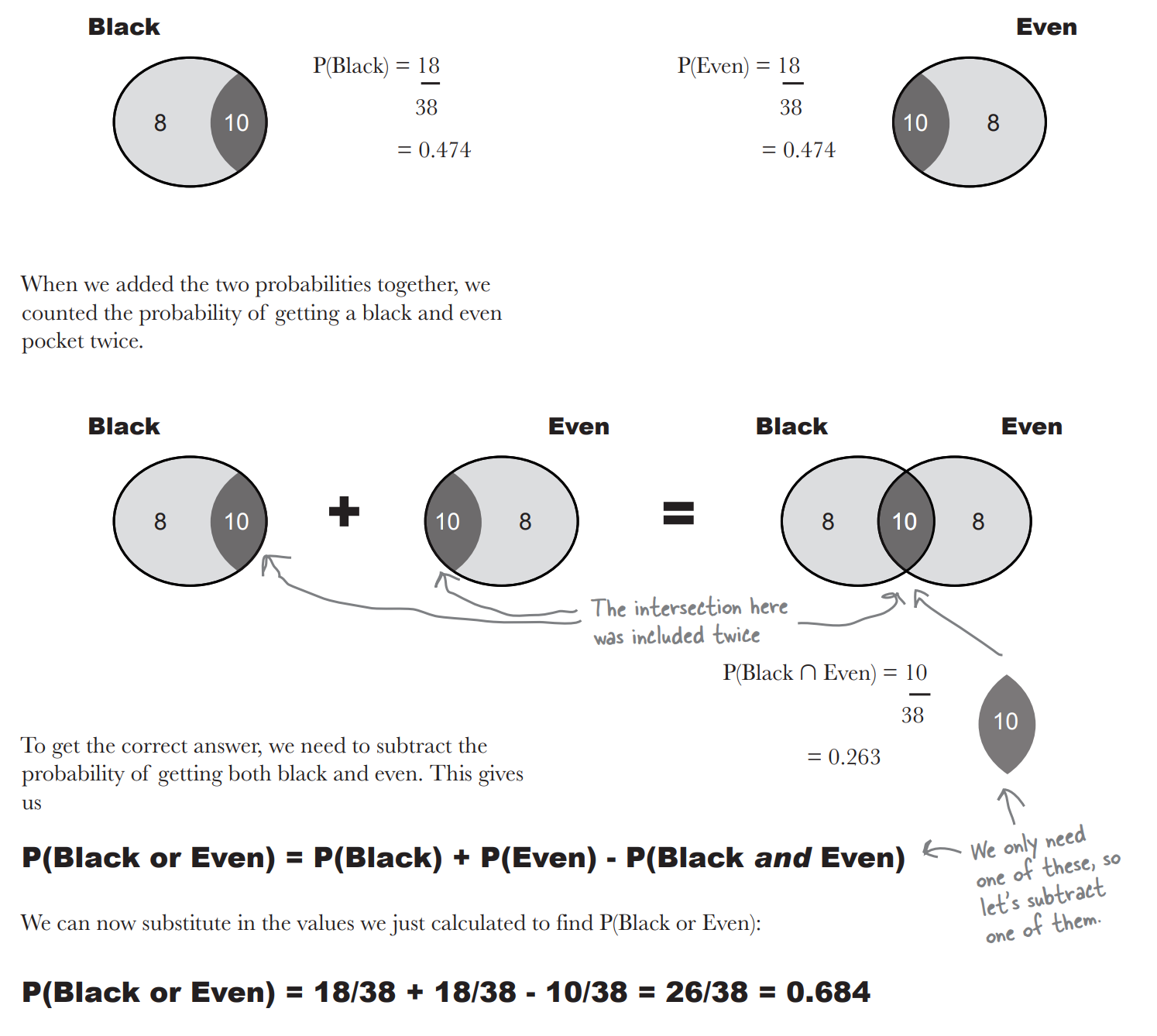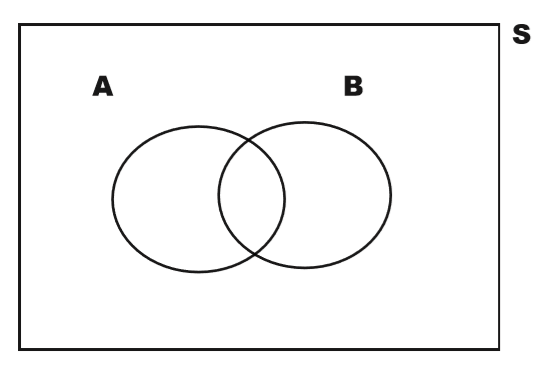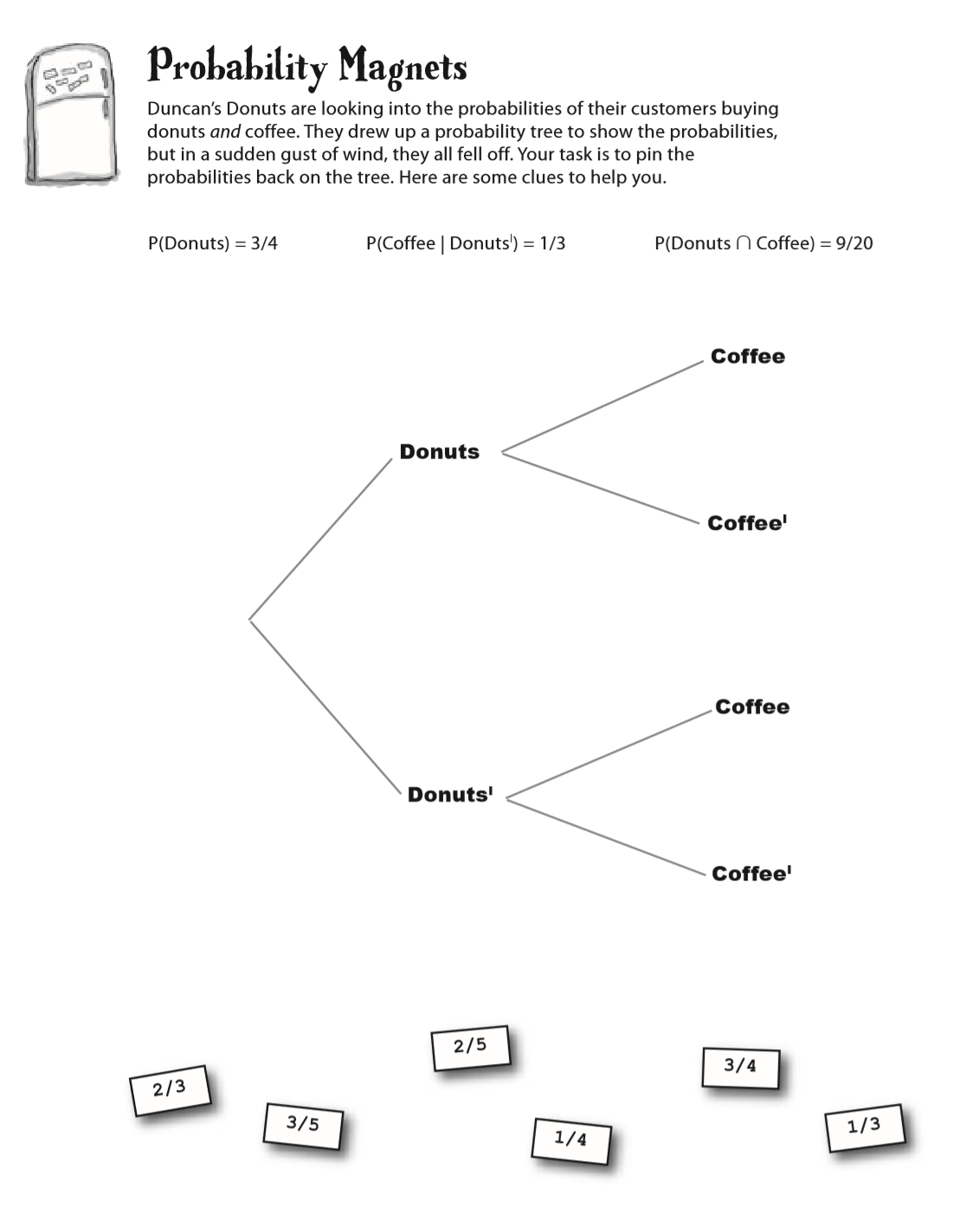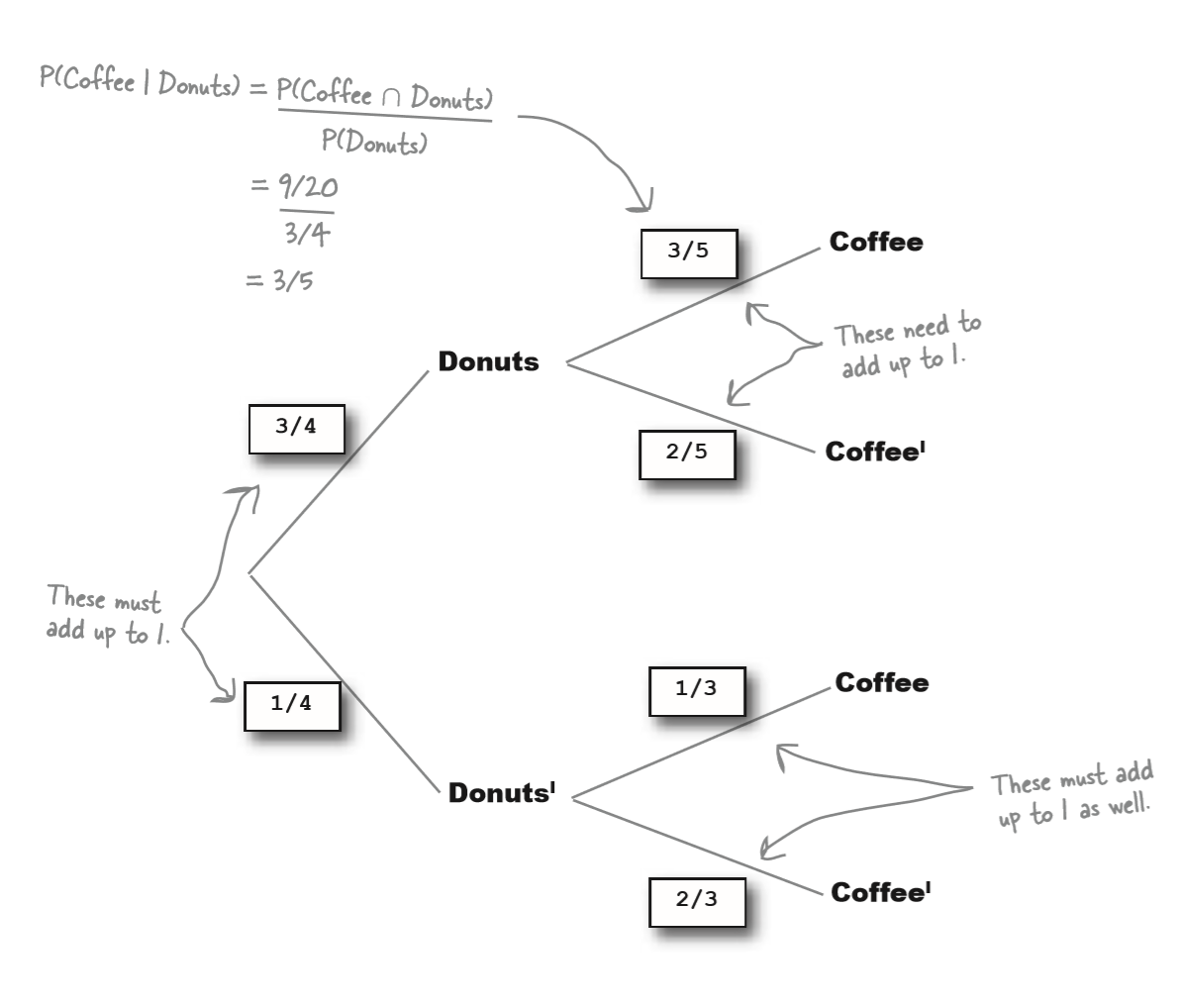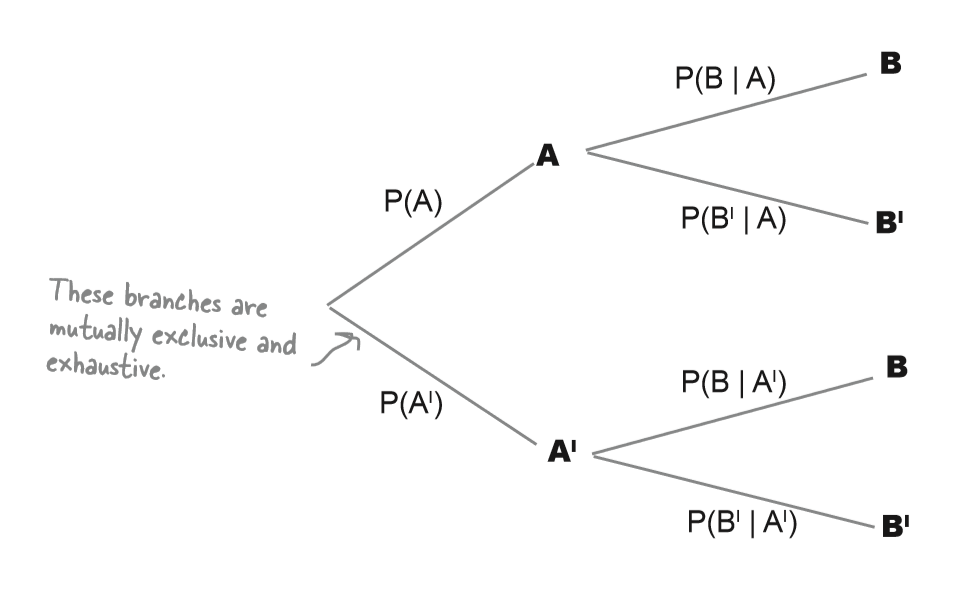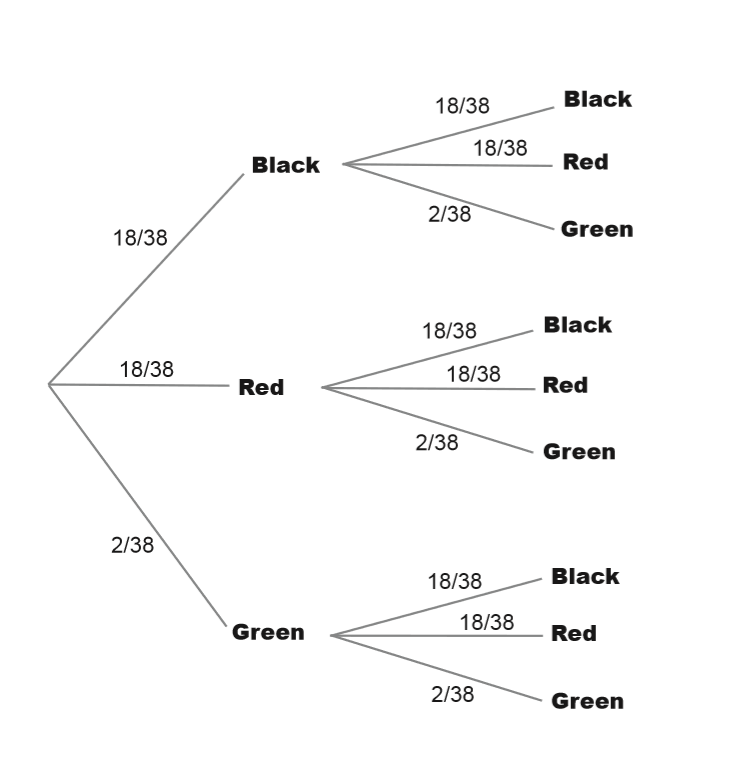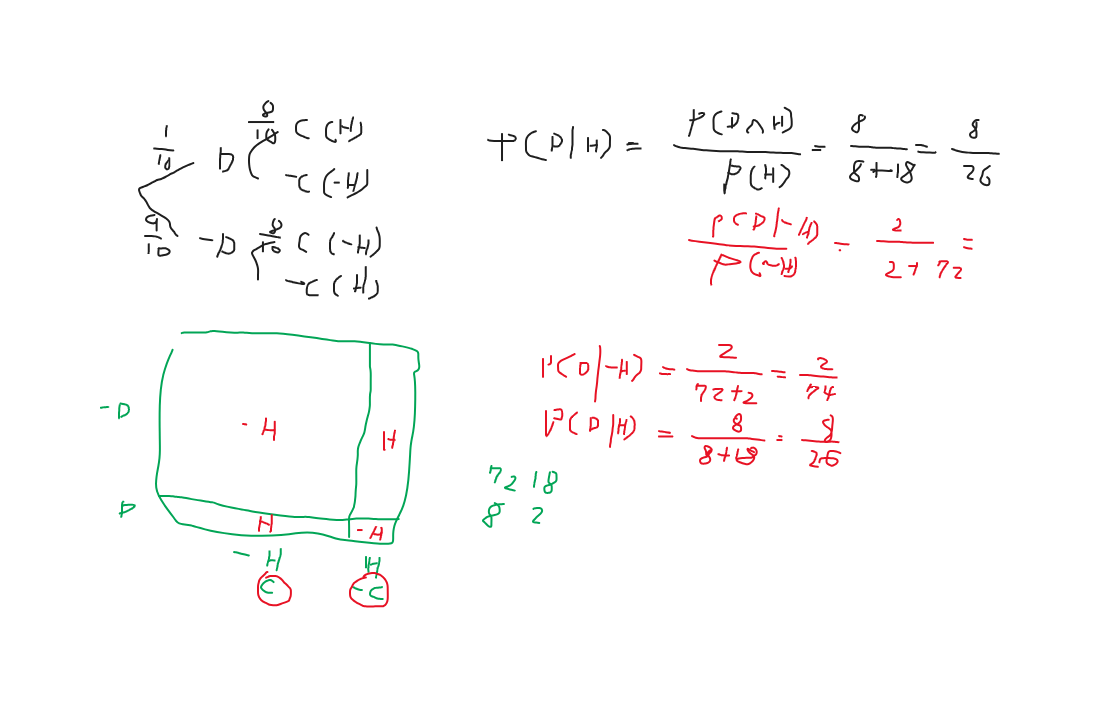Table of Contents
Calculating Probability
How many pockets (holes) are there? 38
. . .
- black = 18 blacks, consisted with
- 8 odd numbers and
- 10 even numbers
- medium grey part = red, consisted with
- 10 odd numbers and
- 8 even numbers
- white (almost) = green, consisted with
- O and
- OO
- #s = numbers (odd and even to 36, plus O, OO)
$$P(A) = \frac {n(A)}{n(S)} $$
Probability of event A happening:
S = space S
A = event A
$$ P(A) + P(A') = 1 $$
$$ P(A') = 1 - P(A) $$
$ P(9) $
$ P(Green) $
$ P(Black) $
$ P(38) $
\begin{eqnarray*} P(\text{Green}) & = & 2 / 38 \\ & = & 0.052632 & = & 0.053 \end{eqnarray*}
\begin{eqnarray*} P(\text{Black or Red}) & = & P(\neg{\text{Green}}) \\ & = & 1 - P(Green) \\ & = & 1 - 0.053 \\ & = & 0.947 \end{eqnarray*}
\begin{eqnarray*} P(\text{Black or Red}) & = & P(\text{B} \cup \text{R}) \\ & = & P(B) + P(R) \\ & = & \frac {18 + 18} {38} \\ & = & \frac {36}{38} \\ & = & 0.947 \end{eqnarray*}
{{:b:head_first_statistics:pasted:20190924-180111.png}}
{{:b:head_first_statistics:pasted:20190924-180227.png}}
{{:b:head_first_statistics:pasted:20190924-180416.png}}
Let’s find the probability of getting a black or even (assume 0 and 00 are not even).
- What’s the probability of getting a black? $ P(B) $
- What’s the probability of getting an even number? $ P(E) $
- What do you get if you add these two probabilities together? $ P(B \cap E) $
- Finally, use your roulette board to count all the holes that are either black or even, then divide by the total number of holes. What do you get? $P(B \cup E)$
- Intersection $ \cap $
- Union $\cup $
- $P(A \cup B) = P(A) + P(B) - P(A \cap B)$
probability of A given B
$ P(A \mid B) $ : The probability of A given that we know B has happened
\begin{eqnarray*} & & P(A \mid B) = \displaystyle \frac {P(A \cap B)}{P(B)} \\ & & P(B \mid A) = \displaystyle \frac {P(B \cap A)}{P(A)} \\ & & P(A \cap B) = P(A \mid B) * {P(B)} \\ & & P(B \cap A) = P(B \mid A) * P(A) \\ \\ & & \text{since},\;\; P(A \cap B) = P(B \cap A) \\ & & P(A \vert B) * {P(B)} = P(B \vert A) * P(A) \\ \end{eqnarray*}
Because we’re trying to find the probability of A given B, we’re only interested in the set of events where B occurs.
Note that
\begin{eqnarray*}
P(A \vert B) & = & \frac {\text{black}}{\text{black + grey}} \\
& = & \frac {P(A \cap B)}{P(B)}
\end{eqnarray*}
\begin{eqnarray*} P(A \cap B) & = & {\text{black}} \end{eqnarray*}
….
Probability magnet
Duncan’s Donuts are looking into the probabilities of their customers buying donuts and coffee. They drew up a probability tree to show the probabilities, but in a sudden gust of wind, they all fell off. Your task is to pin the probabilities back on the tree. Here are some clues to help you.
- P(Donuts) = 3/4
- P(Coffee | ㄴDonuts) = 1/3
- P(Donuts ∩ Coffee) = 9/20
3/4, 1/4, 2/5, 3/5, 1/3, 2/3
- P(Donuts')
- P(Donuts' ∩ Coffee)
- P(Coffee' | Donuts)
- P(Coffee)
- P(Donuts | Coffee)
d (3/4) -- c [x = 3/5] [k = p(c and d)]
-- ~c [y = 2/5]
~d (1/4) -- c (1/3) --> [a = p(c and ~d)]
-- ~c [2/3]
x * 3/4 = p(d and c) = 9/20
x = 9/20 * 4/3
= 36/60
= 6/10 = 3/5
P(~d ∩ c) = a = 1/4 * 1/3 = 1/12
P(c) = k + a
k = 3/4 * 3/5 = 9/20
a = 1/12
P(c) = 54/120 + 10/120 = 64/120 = 16/30 = 8/15
c (8/15) -- d [j] [P(d and c) = 9/20]
-- ~d
~c (7/15)
j = p(d | c)
p(d and c) = 9/20 이므로
8/15 * j = 9/20
j = 9/20 * 15/8 = 9/4 * 3/8 = 27/32
Q: I still don’t get the difference between P(A ∩ B) and P(A | B).
A: P(A ∩ B) is the probability of getting both A and B. With this probability, you can make no assumptions about whether one of the events has already occurred. You have to find the probability of both events happening without making any assumptions. P(A | B) is the probability of event A given event B. In other words, you make the assumption that event B has occurred, and you work out the probability of getting A under this assumption.
Q: So does that mean that P(A | B) is just the same as P(A)?
A: No, they refer to different probabilities. When you calculate P(A | B), you have to assume that event B has already happened. When you work out P(A), you can make no such assumption.
Q: Is P(A | B) the same as P(B | A)? They look similar.
A: It’s quite a common mistake, but they are very different probabilities. P(A | B) is the probability of getting event A given event B has already happened. P(B | A) is the probability of getting event B given event A occurred. You’re actually finding the probability of a different event under a different set of assumptions.
Q: Are probability trees better than Venn diagrams?
A: Both diagrams give you a way of visualizing probabilities, and both have their uses. Venn diagrams are useful for showing basic probabilities and relationships, while probability trees are useful if you’re working with conditional probabilities. It all depends what type of problem you need to solve.
Q: Is there a limit to how many sets of branches you can have on a probability tree?
A: In theory there’s no limit. In practice you may find that a very large probability tree can become unwieldy, but you may still find it easier to draw a large probability tree than work through complex probabilities without it.
Q: If A and B are mutually exclusive, what is P(A | B)?
A: If A and B are mutually exclusive, then P(A ∩ B) = 0 and P(A | B) = 0. This makes sense because if A and B are mutually exclusive, it’s impossible for both events to occur. If we assume that event B has occurred, then it’s impossible for event A to happen, so P(A | B) = 0.
Swap the order of buying. What do you get?
...
Maybe we can win some chips back with another bet. This time, the croupier says that the ball has landed in an even pocket. What’s the probability that the pocket is also black?
$$ P(Black \vert Even) = \frac {P(Black \cap Even)}{P(Even)} $$
Step 1: Finding P(Black ∩ Even)
\begin{eqnarray*}
P(Black \cap Even)
& = & \frac {18}{38} * \frac {10}{18} \\
& = & \frac {10}{38} \\
P(Black \vert Even) & = & \frac {P(Black \cap Even)}{P(Even)} \\
P(Black \cap Even) & = & P(Black) * P(Even \vert Black) \\
P(Black \vert Even) & = & \frac{P(Black) * P(Even \vert Black)} {P(Even)}
\end{eqnarray*}
Step 2: Finding P(Even)
\begin{eqnarray*} P(Even) & = & P(Black \cap Even) + P(Red \cap Even) \\ & = & P(Black) * P(Even \vert Black) + P(Red) * P(Even \vert Red) \\ & = & \frac{18}{38} * \frac{10}{18} + \frac{18}{38} * \frac{8}{18} \\ & = & \frac{18}{38} \\ & = & \frac{9}{19} \end{eqnarray*}
Step 3: Finding P(Black l Even)
$$ P(Black \vert Even) = \frac {P(Black \cap Even)} {P(Even)} $$
We started off by finding an expression for P(Black ∩ Even)
\begin{eqnarray*}
P(Black \cap Even) & = & P(Even \cap Black) \\
& = & P(Black) * P(Even \vert Black)
\end{eqnarray*}
After that we moved on to finding an expression for P(Even), and found that
$$ P(Even) = P(Black) * P(Even \vert Black) + P(Red) * P(Even \vert Red) $$
Putting these together means that we can calculate P(Black | Even) using probabilities from the probability tree
\begin{eqnarray*} P(Black \vert Even) & = & \frac {P(Black \cap Even)}{P(Even)} \\ & = & \frac { P(Black) * P(Even \vert Black)}{P(Black) * P(Even \vert Black) + P(Red) * P(Even \vert Red)} \\ & = & \frac{5}{19} / \frac{9}{19} \\ & = & \frac{5}{19} * \frac{19}{9} \\ & = & \frac{5}{9} \\ \end{eqnarray*}
Think backward again
Draw a tree line for Odd, Even, Green probability first, then Black and White.
Bayes' Theorem
Bayes' Theorem
Generalization
\begin{eqnarray*}
& & P(A \mid B) = \frac {P(A \cap B)}{P(B)} \\
& & P(A \cap B) = P(B) * P(A \mid B) \\
& & P(B \cap A) = P(A) * P(B \mid A) \\
\\
& & \therefore & & \\
& & P(A \cap B) = P(A) * P(B \mid A) \\
\\
& & \therefore \\
& & P(A \mid B) = \frac {P(A) * P(B \mid A)} {P(B)} \\
\\
& & \text{also, } \because{} \\
& & P(B) = P(A) * P(B \mid A) + P(\neg{A}) * P(B \mid \neg{A}) \\
& & P(A \mid B) = \frac {P(A) * P(B \mid A)} {P(A) * P(B \mid A) + P(\neg{A}) * P(B \mid \neg{A})} \\
\end{eqnarray*}
This is called “Bayes' Theorem”
e.g.
The Manic Mango games company is testing two brand-new games. They’ve asked a group of volunteers to choose the game they most want to play, and then tell them how satisfied they were with game play afterwards. 80 percent of the volunteers chose Game 1, and 20 percent chose Game 2. Out of the Game 1 players, 60 percent enjoyed the game and 40 percent didn’t. For Game 2, 70 percent of the players enjoyed the game and 30 percent didn’t. Your first task is to fill in the probability tree for this scenario.
Manic Mango selects one of the volunteers at random to ask if she enjoyed playing the game, and she says she did. Given that the volunteer enjoyed playing the game, what’s the probability that she played game 2? Use Bayes’ Theorem.
Dependent and Independent event
$P(E|B) = 10 /18$
$P(E) = 18 / 38$
if $P(E|B) \ne P(E)$ true,
then the two events are dependent.
$P(B) = 18 / 38$
$P(B|B) = 18 / 38$
If $P(A|B) = P(A)$ is true,
then the two events are independent.
$ P(\text{A} \vert \text{B}) = \displaystyle \frac {P(\text{A} \cap \text{B})}{P(\text{B})} $ 이므로
그리고, 만약에 위가 참이라면
$ P(A) = \displaystyle \frac {P(A \cap B)}{P(B)} $
따라서,
$ P(A \cap B) = P(A) * P(B) $
- Throwing a coin and getting heads twice in a row.
- Removing socks from a drawer until you find a matching pair.
- 양말을 한 짝 꺼낸 후, 다시 넣지 않았으므로 다음 양말을 꺼낼 때의 확률이 달라지게 됨. 따라서, 종속된 이벤트.
- Choosing chocolates at random from a box and picking dark chocolates twice in a row.
- Choosing a card from a deck of cards, and then choosing another one.
- Choosing a card from a deck of cards, putting the card back in the deck, and then choosing another one.
- The event of getting rain given it’s a Thursday
- 목요일이라고 해서 비가 오거나 오지 않을 확률이 낮아지거나 높아지지 않음
The Absent-Minded Diners
Three absent-minded friends decide to go out for a meal, but they forget where they’re going to meet. Fred decides to throw a coin. If it lands heads, he’ll go to the diner; tails, and he’ll go to the Italian restaurant. George throws a coin, too; heads, it’s the Italian restaurant; tails, it’s the diner. Ron decides he’ll just go to the Italian restaurant because he likes the food.
- What’s the probability all three friends meet?
- What’s the probability one of them eats alone?
{{:b:head_first_statistics:pasted:20250922-074827.png}}
- The probability of the ball having landed on the number 17 given the pocket is black.
- The probability of the ball landing on pocket number 22 twice in a row.
- The probability of the ball having landed in a pocket with a number greater than 4 given that it’s red.
- The probability of the ball landing in pockets 1, 2, 3, or 4.
exercises
1
https://youtu.be/NIqeFYUhSzU?t=904
아미라와 재인은 지각을 할 때가 있다. 전체 기간 중에는 70%는 둘 다 지각하지 않고 학교에 등교를 한다. 전체 기간 중에 아미라는 20% 지각을 하고 재인은 25% 지각을 한다. 지난 주 월요일에 재인은 지각을 했다. 아미라가 지각할 확률을 구하라.
2
https://youtu.be/NIqeFYUhSzU?t=1296
타냐는 테니스치는 것을 좋아하는데, 날씨가 좋을 때는 특히 즐겨 친다. 날씨가 좋을 때 타냐가 테니스를 치는 확률은 80%이고 날씨가 좋지않을 때는 35% 이다. 특정한 날에 날씨가 좋을 확률은 60%라고 한다. 지난 일요일에 타냐는 테니스를 쳤다. 이날 날씨가 좋았을 확률은 어떻게 되는가?
3
불경기 대 톰은 직업을 잃을 확률이 40% 이다. 보통 때는 5%이다.
해마다 불경기가 올 확률은 10% 라고 한다.
작년에 톰은 직업을 읽었다. 이 때 불경기였을 확률은 얼마인가?
4
https://youtu.be/NIqeFYUhSzU?t=2550
- 사람들이 병에 걸릴 확률은 10% 이다.
- 병에 걸렸는지 확인하는 테스트가 맞을 경우는 80% 이다.
- 병원에 가서 테트스틀 해보니 병에 걸렸다고 한다. 실제 병에 걸렸을 확률은?
5
Question
- 공무를 수행하기 위해서 불법약물을 복용하는지 테스트를 한다고 한다.
- 사람들이 실제 약물을 수행하는 확률은 4% 라고 (0.04) 한다.
- 사람들이 약물을 복용하지 않는데 복용한다고 하는 테스트 결과의 (false positive) 확률은 5% 라고 한다.
- 약물을 복용하는데 복용하지 않는다고 하는 테스트 결과의 (false negative) 확률은 10% 라고 한다.
- 테스트 결과가 양성으로 나올 확률은 얼마인가?
- 약물을 복용한다는 테스트 결과가 나왔는데, 실제로는 약물을 복용하지 않을 확률은 얼마인가?
- 이 확률 계산의 중요성에 (significance) 대해서 확인할 것
6
Question
- 공항의 수하물가방 검색에서 무기가 발견될 확률은 5% 라고 한다.
- 검색결과가 정확할 확률은 90% 라고 한다.
- 검색에서 무기가 발견되었는데 사실은 무기가 아닐 확률은 (false positive) 얼마인가?


